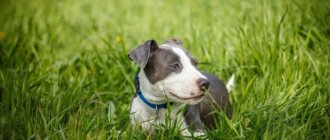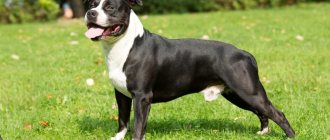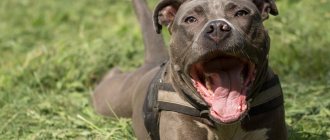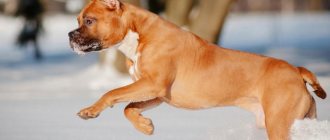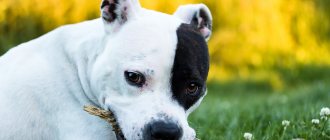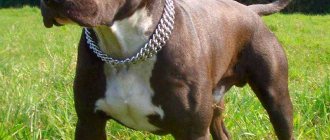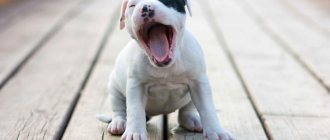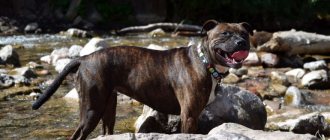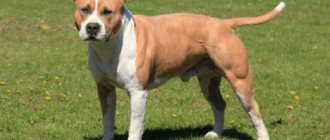How to care for your pet
The Staffordshire Terrier is a fighting dog that is a pleasure to care for.
To prevent your pet's short hair from shedding (sticking to furniture, carpets, clothes), you need to comb it with a special comb with coarse bristles.
In summer, short hair does not cause discomfort to the dog. However, in autumn and winter, when the temperature drops and it is quite chilly and wet outside, the Staffordshire Terrier needs special clothing.
Today, every educated person and caring owner understands that warm clothing for short-haired dogs is not a fashion statement, a fad or an unjustified luxury, but a necessity and rational concern for the health of the pet.
To make walking in winter a joy, breeders recommend wearing:
The choice of a separate accessory depends largely on the weather and ambient temperature.
For damp, cool weather, clothing made of waterproof fabric is ideal.
But for lower temperatures it is better to give preference to two-layer models with natural insulation: flannel, fleece.
For harsh winter days, the ideal clothing is a blanket, the main function of which is to protect “weak points”, namely: the genitourinary system and kidneys.
The appearance of a pet in the house
If there is a small child in the family, you don’t have to worry, because the Amstaff’s behavior with children is distinguished by caution and understanding.
The dog knows very well that the child is much weaker and will succumb to the baby; it gets along well not only with children, but also with other pets.
Owners can recognize health problems by the following signs:
- Amstaff's nose is warm and completely dry, the pupils of the eyes are dull;
- poor sleep and loss of appetite;
- unpresentable appearance of dog hair, loss of shine;
- frequent urge to urinate, even breathing and wet mucous membranes.
American Staffordshire Terrier puppies need care and proper grooming. To prevent your dog from getting sick, you need to bathe it on time, walk it, and brush its teeth, ears and nose.
If you are thinking about buying a puppy of this breed, you need to know what types of terriers are available and what are their differences.
Clothing selection criteria
Qualified breeders know that you need to carefully choose clothes for your pet.
Warm clothing is an accessory that not only retains heat, but can also become one of the causes of mechanical damage to the skin, an allergic reaction or other pathology.
Therefore, in order to avoid many troubles in the future, you need to know how to choose correctly.
The main criteria are:
Naturalness. Clothes for dogs should be made only from natural materials.
It is possible to use synthetic fabrics for the outer layer. However, at the same time, the inner layer in contact with the pet’s fur should only be made of natural fabric.
Due to the fact that synthetic fabrics contribute to the matting of fur in clumps, the accumulation of static electricity, the dog may feel discomfort, and the pet’s aesthetics will deteriorate.
Accessories. Breeders recommend purchasing clothes for the Staffordshire Terrier with fasteners on the back. This way, the pet will not be able to reach the fittings with its teeth and ruin the clothes.
For staffs, the ideal accessory option for clothing is a zipper, which reliably protects the pet from the cold and does not allow fur to get into the teeth.
Seam processing. Inner seams should be stitched outwards. This is the only way to prevent damage to the animal’s skin and chafing.
Compliance with size and dimensions. Clothes for your dog should be the right size. It should not hinder movement or interfere.
Colors. With pleasure, your pet will wear only those clothes that he likes.
Needless to say, the Staffordshire Terrier is a fighting dog, so clothes with polka dots and butterflies in delicate tones are unlikely to match the pet’s tastes or be in perfect harmony with his inner world.
Breed varieties
Show-class staff belong to high-breed dogs and have clearly defined qualities described in the breed standard.
This puppy is worth buying if you are serious about preparing for exhibitions, competitions, or want to open a kennel of American Staffordshire Terriers.
Breeding class - such dogs are also called breeding dogs, these are typical representatives of the Amstafa breed, which do not have strong deviations from the breed standard, and are suitable for exhibition and breeding.
Pet class. Such a pet may have defects. This could be an asymmetrical skull, dental irregularities, an unusual color for a Staffordshire Terrier, or an atypical tail shape.
Such defects do not have negative consequences for the health of puppies, but they are not suitable for breeding.
Where to buy new things?
Clothing for a Staffordshire Terrier is not a luxury!
You can buy it in a specialized store, or order it online, or sew it yourself.
The only criterion when choosing clothes is comfort.
The dog should always feel comfortable and warm!
When choosing clothes through an online store, you need to pay attention to the size. Since each dog is individual, experienced breeders recommend taking measurements from the pet to compare the parameters of the product with the dimensions.
Photo gallery
Today, many dog owners, in an effort to highlight their pet, can dress their pet not only for daily walks, if necessary, but also for photo shoots and attract attention.
How do Staffords cope with the cold? Who keeps it in the yard?
Mine is sleeping under a blanket at home, and you’re talking about some kind of yard!
Yes, they don’t tolerate it well, they don’t have undercoat. They'll die of hypothermia, damn it.
Neither staffs nor pits can be kept in the yard! Only in the house, with active walks outside. Do you want a dog in the yard? Start an Alabai, BUT, VEO. Don't mock the staff.
my little one sometimes curls up his paws on walks (if he doesn’t play or jump), although I know Pete, they keep him in a warm box all year round
He can run around in the snow all day, but in winter he can only sleep indoors.
The only thing I don’t understand is why short-haired dogs should be brought into the yard. It seems that there are no other breeds or that you have not heard of them. Or the word staff fascinates, but it’s scary to keep it in the house, lest something happen.
Fine. Provided that the dog actively moves during a walk and does not stand still. Staffies love to run around in the snow and play snowballs. In addition, for example, “running through snowdrifts” or simply through deep snow is useful for muscle development. Of course, in severe frosts (from -15) it is better to limit yourself to short walks, as there is a high risk of catching a cold.
Such dogs are not kept in the yard, have you seen their fur? What kind of maintenance in the yard, in this case, can we talk about? You can walk them in the cold if the dog does not mark time, but runs, jumps, and communicates with other dogs. But this is for an hour, an hour and a half! A friend of mine kept a dog without undercoat in her yard. The dog howled every night from cold and pain.
Staffs should not be kept on the street under any circumstances! This dog is short-haired; Amstaffs have no undercoat. She loves to walk in the snow, but only in moderation.
Source
The character of doggies and their upbringing
The Amstaff puppy looks like a chubby round puppy with a bare belly.
He is very active, enjoys chewing on slippers and loves to misbehave in the house in every possible way.
For this reason, from the first days of acquaintance, you need to educate him and accustom him to order.
To prevent your dog from dragging your socks, T-shirts and other items around the room, make sure you have a sufficient arsenal of toys. They should be made of a variety of materials.
There are whole myths and legends about the aggressive character traits of Staffordshire Terriers. It depends only on the owners how this pet will grow up.
If you abandon your dog and do not pay enough attention to its upbringing, the older dog may become angry and show aggression.
To achieve obedience and correct behavior from a four-legged animal, follow some rules.
Namely:
The educational process should begin at the age of no later than 1.5-6 months. Even as a baby, a terrier must understand what behavior is acceptable and what is not.
Then you won’t have any difficulties when the dog grows up and his character develops.
Introduce your four-legged friend to the environment from the very first days, always praise for correctly executed commands and punish for misbehavior and incorrect behavior.
But you cannot punish a dog by shouting or using physical force.
Provide your pet with a well-chosen and balanced menu. You can consult your veterinarian on this issue.
The diet must contain water, dietary supplements, minerals and vitamins of groups A, B, C, D, E, K.
Staffordshire Bull Terrier puppies are smaller than American Staffordshire Terriers, but both breeds have bold personality traits.
Such dogs are good protectors and loyal friends for the whole family. With the right approach to education, a terrier is distinguished by its intellectual abilities and the ability to restrain emotions even under the most unexpected circumstances.
Staffordshire Bull Terrier
| Country of origin: | Great Britain |
| Weight: | males 12.7-17 kg, females 11-15.4 kg |
| Height at withers: | 35.5-40.5 cm |
| Color: | white, fawn, red, blue, black, brindle; all colors with or without white markings |
Staffordshire Bull Terriers are very agile, strong dogs, they have short, thick, smooth hair. In relation to their height, the Stafford's body is disproportionately long, and their low center of gravity gives them stability. Their small size and highly developed muscles make Staffordshire Bull Terriers one of the strongest and most robust dogs. The head of these dogs is large and wide.
How do Staffords cope with the cold? Who keeps it in the yard?
It's easy and interesting to communicate here. Join us!
Mine is sleeping under a blanket at home, and you’re talking about some kind of yard!
He can run around in the snow all day, but in winter he can only sleep indoors.
Fine. Provided that the dog actively moves during a walk and does not stand still. Staffies love to run around in the snow and play snowballs. In addition, for example, “running through snowdrifts” or simply through deep snow is useful for muscle development. Of course, in severe frosts (from -15) it is better to limit yourself to short walks, as there is a high risk of catching a cold.
Staffs should not be kept on the street under any circumstances! This dog is short-haired; Amstaffs have no undercoat. She loves to walk in the snow, but only in moderation.
The only thing I don’t understand is why short-haired dogs should be brought into the yard. It seems that there are no other breeds or that you have not heard of them. Or the word staff fascinates, but it’s scary to keep it in the house, lest something happen.
Such dogs are not kept in the yard, have you seen their fur? What kind of maintenance in the yard, in this case, can we talk about? You can walk them in the cold if the dog does not mark time, but runs, jumps, and communicates with other dogs. But this is for an hour, an hour and a half! A friend of mine kept a dog without undercoat in her yard. The dog howled every night from cold and pain.
Neither staffs nor pits can be kept in the yard! Only in the house, with active walks outside. Do you want a dog in the yard? Start an Alabai, BUT, VEO. Don't mock the staff.
my little one sometimes curls up his paws on walks (if he doesn’t play or jump), although I know Pete, they keep him in a warm box all year round
Yes, they don’t tolerate it well, they don’t have undercoat. They'll die of hypothermia, damn it.
Fine. Provided that the dog actively moves during a walk and does not stand still. Staffies love to run around in the snow and play snowballs. In addition, for example, “running through snowdrifts” or simply through deep snow is useful for muscle development. Of course, in severe frosts (from -15) it is better to limit yourself to short walks, as there is a high risk of catching a cold.
Website about dogs
By purchasing a Staffordshire Terrier, you can be sure that a dog of this breed will not cause you unnecessary trouble, but, on the contrary, you will receive a lot of positive emotions in the process of raising it.
From the first months of his life, the Stafford will try to please you in everything. At the same time, it is very important to raise your friend correctly, only in this case you will get a dog with an excellent, balanced and friendly character. Although there are often cases when, due to cruel treatment of a dog, its owners ended up with an aggressive animal.
It is also important that this breed does not require any special additional care. You can keep an animal, even if you live in a small apartment, it will not need a lot of space, it is important to systematically work with your pet, go for walks with it and balance its diet.
If you are planning to buy yourself a loyal and intelligent friend, then you should, without hesitation, buy a Staffordshire Terrier puppy. This can be done through a specialized store, or through friends; it is also possible to use the services of the website ria.ua, where there is a huge number of advertisements from people who are professionally involved in breeding dogs.
How Staffords Handle the Cold
How does the Staffordshire Terrier cope with cold and winter?
how long can you walk with him in winter?Added 2 years ago=)Added 2 years ago=)Added 2 years ago)))
I have a smooth one (not a staff one) - in very cold weather we wear a blanket for a walk. If it’s below -15, we walk “naked”) for 20-30 minutes.
He will be able to walk for 15 minutes without a suit at -30, then he will be able to go home..
They are smooth-haired, without undercoat, and can die on the street. and if he lives in a warm place just to go for a walk, he tolerates everything fine
Buying and selling
Where is it generally customary to buy and sell these animals? First of all, we need to talk about nurseries.
By choosing an American Staffordshire Terrier kennel, you can find a healthy and beautiful dog of this breed.
But be prepared for the corresponding prices; check immediately how much a puppy costs in a particular nursery.
In such places, the best puppies of the litter are often kept, and the rest are offered for sale, and at an exorbitant price.
On the Internet you can find out how much such a puppy costs from private sellers. In this case, you need to try to protect yourself by asking the sellers to show not only the staff, but also his parents.
This method is good because it will be convenient to pick up the puppy in your city. But despite the prices, nurseries are safer places for such purchases.
If you decide to become a Stafford breeder yourself, know that it is troublesome, but can bring good income.
These puppies have always been appreciated, how much does a staff cost?
The price varies between 50-1000 dollars, depending on the pedigree, documents and place of purchase.
Once you get such a dog, you won’t want another one; the Stafford is a wonderful companion, a guard and just a funny dog!
Feeding the dog in winter
Changing their diet in winter is important for working and outdoor dogs because they need more energy to generate heat. First of all, it is necessary to increase the calorie content of foods, but not the serving size. However, if when feeding natural products you can increase the calorie content by adding vegetable oil, offal, boiled udder, beef tripe and trimmings with a fatty layer, then when feeding dry food it is difficult to do this. In this case, you can replace the usual food with food for active dogs (Bosch Active) or gradually increase the portion size, for example, if in the warm season the pet consumed 600 grams of dry food, then in winter it will need 800 grams. It is important to prevent a lack of vitamins E and B; to do this, you need to introduce foods rich in these vitamins into your diet or give additional vitamin supplements.
The water problem can be solved. Of course, some dog breeders are ready to regularly add boiling water to a dog living on the street so that the water does not freeze, but this option is not the best. In winter there is a lot of snow, which animals eat if they are thirsty. During the period when it is already cold outside, the water is freezing, but there is no snow yet, you can give your pet a piece of ice that he will lick. There is no need to worry that your pet will get sick, because the animal swallows a small amount of snow, which manages to warm up before it reaches the stomach. Some enterprising owners place a special mat (for example, for reptiles) in the enclosure to heat the water. In this case, care should be taken to ensure that the animal does not chew through the wires.
Food for dogs that live on their faces should be given warm in a plastic bowl (the tongue may stick to a metal bowl), but it is not recommended to fill dry food with warm water because it hardens quickly, and some dogs refuse soaked dry kibble.
Changes in diet should not affect low-active pets living in apartments. They do not need to expend energy, they are always warm, and increasing the calorie content of food will lead to obesity.
It is worth considering when feeding dogs in winter that females spend less energy than males, young dogs need more food than older dogs.
Care and maintenance
Teeth
Many owners, due to their inexperience, begin to play the game “tug of war” with terrier puppies.
This game is very useful and interesting for pets, but at the age of up to 4 months, it can be dangerous for the baby.
The essence of the game is to take away a rope or piece of fabric from each other. For this activity, buy a rope at a specialty store.
Why might this be dangerous for the puppy? She may develop an incorrect bite, and when all the teeth are fully formed, she can play with a rope or string without fear.
When all the teeth are replaced with new ones, they need care. The dog is not able to provide the necessary care for its oral cavity on its own.
You will need dog toothpaste, which should be periodically applied to your puppy's teeth with your fingers or a brush.
Never use human toothpaste, it is very foamy and causes stomach upset in animals.
Feeding
Staffordshire Terrier puppies must get used to a certain diet during childhood.
In the first months of life, they are fed up to 5-6 times a day, but in small portions so that the baby does not overeat.
If you find leftover food after eating, hide it until next time. Don't let your dog eat at random.
Your pet should have only water freely available at all times, because he spends a lot of energy reserves and strength on games and pampering.
As they grow older, the number of meals is reduced, but the volumes increase. Upon reaching 4 months, the dog eats three meals a day, and an adult dog needs two meals.
Treatment
Your home must have a first aid kit containing everything your pet needs in case emergency assistance is needed.
Puppies are like children and strive to climb absolutely everywhere, they can chew through wires, dump something heavy on themselves, and so on.
The first aid kit should contain iodine, bandages, medications for treating the animal after injury, painkillers and other medications.
Your veterinarian can advise you on a more extensive list that you should stock up on.
Walking the dog in winter
With the onset of cold weather, it is recommended to reduce the walking time, but this does not mean that you need to go outside less often. You can walk more often for 15-20 minutes. The duration of the walk depends on the specific dog, its coat type, fat reserves, activity level, health, age, as well as weather conditions. Walking in calm, frosty weather is safer than in windy and snowy weather. Healthy animals suffer less from cold than puppies, elderly, pregnant, and sick dogs.
For winter walks, dogs that do not tolerate cold well need warm winter clothing, such as a sweater, overalls, coat, fur coat and, of course, shoes. Warm clothing protects against hypothermia. In addition to protection from the cold, clothing and shoes protect your pet from cuts on ice, sharp objects hidden under snow, and from exposure to reagents that can get on the fur and paws. Dogs are prone to licking fur, from which toxic substances can enter the stomach, causing poisoning. There are different types of shoes for dogs and their choice should be approached responsibly. If the animal does not like to wear shoes, then before walking the pet’s paws need to be treated with special products that create a protective film on the paws.
During walks, the dog should behave actively: run, play. The owner should not allow the pet to lie for a long time in the snow, eat snow (in cities, snow contains harmful substances, such as antifreeze, reagents that, when ingested, cause poisoning, in some cases leading to death), walk without a leash near rivers and reservoirs , along roadsides, where harmful substances accumulate in the greatest quantities. You cannot walk your dog on ice, which can cause dislocations, sprains, bruises and even fractures.
When walking your dog in icy conditions, it is better to keep the animal on a short leash to control it. You should not walk through snowdrifts, especially if the snow is not dense. Under the snow there may be dangerous sharp objects that can injure your pet, or iron objects that your pet can accidentally stick their tongue to.
In winter it gets dark earlier and it is important to be careful while walking. To prevent your dog from running out onto the roadway, to always be in sight and noticeable to other people and motorists, it is better to walk your pet in reflective clothing. It would be a good idea to use a collar and leash that are clearly visible in the dark.
The signal for the end of the walk is the characteristic behavior of the animal, namely the dog begins to tremble, whine, tuck its paws, cower, and quickly run towards home.
Long walks can cause frostbite. The places most sensitive to cold are the ears, paws, scrotum, and mammary glands.
After a walk, you need to wash your pet’s paws with lukewarm, but not hot water, which will cause the pads to crack, inspect the paws for cuts, and wipe the fur in the belly area with a damp cloth.
How to walk with a Staff puppy
Constant walks of Staffies are a sacred duty of their owners.
Staff is a sporty dog, so walking time is 2-3 hours a day (minimum 1 hour).
- You should not wash your dog often, the norm is 1-2 times a year (the first time - no earlier than 4 months). You should only use shampoo when your pet is very dirty. Insecticidal Zooshampoos with herbal extracts, for example ZSh “Lugovoi”, are best suited for this.
- A dog's nails need to be trimmed when they grow long. Long claws interfere with walking and spoil the gait. If self-grinding on the asphalt does not occur, use a special claw cutter or grind it with a needle file, a file, or a diamond nail file. Puppies under 6 months of age need to have their nails trimmed once a week, up to a year old - once every 2 weeks, and dogs older than a year - once every 2-4 weeks. We cut only the tip of the nail below the living part, trying not to touch the pulp (otherwise you will have to stop the bleeding with brilliant green). If you still overdid it and you can’t stop the bleeding with brilliant green, cauterize the pulp with several crystals of Potassium Permanganate poured onto a piece of cotton wool (napkin, bandage).
- It is necessary to wash or wipe the paws after each walk. We periodically inspect the pads of the paws, interdigital spaces and claws (whether glass shards, plant thorns, chewing gum, or plasticine are stuck in the pads).
- Ears should be cleaned once a week with a slightly damp cotton swab or sterile cloth using special ear cleaning solutions. Periodically, you can treat the auricle with antibacterial and anti-inflammatory lotions.
- Teeth and gums - monitor the condition of the internal oral cavity and try to prevent the formation of tartar.
- Eyes - wipe if necessary with a damp cotton swab.
- Wash or wipe the face after each feeding with steamed food or natural food.
- It is best to clean the anal glands when you wash your dog after a walk. If you cannot squeeze out the contents of the glands, ichthyol suppositories help very well - one per day for 3-4 days. If the glands do not cause concern, they do not require any special care or cleaning.
- Brush wool up to 6 months once a week, after 6 months - every other day, over a year - daily; once a month wipe with the following composition: 1 tbsp. water, 1 tbsp. vinegar, 1 tbsp. alcohol (vodka). To do this, moisten a napkin or sponge, squeeze it lightly and wipe it over the fur - to protect it from parasites and make it easier to keep it clean and shiny.
Dog breeds that tolerate cold well
Alaskan Malamute, Siberian Husky, Akita, German Shepherd, Caucasian Shepherd, East European Shepherd, Belgian Shepherd, White Swiss Shepherd, South Russian Shepherd, Australian Shepherd, Anatolian Shepherd, Bobtail, Chow Chow, Czech Wolfdog, Moscow Watchdog, Great Pyrenees mountain dog, St. Bernard, Rottweiler, Leonberger, Tibetan mastiff, Norwegian Elkhound, Grosser, Samoyed, Bernese Mountain Dog, long-haired collie, black terrier, Sheltie, Irish wolfhound.
Caring for a dog in winter
By following simple rules for caring for animals in winter, you can protect your pets from a number of dangers.
Decorative breeds living in an apartment need warm everyday clothing, because they do not tolerate cold well and can freeze even in a heated room.
Like humans, animals, when they are cold and try to curl up into a ball, look for a cozy and warm place in the house. Therefore, you should take care of a sleeping place in which the animal will sleep comfortably.
Dogs need to be bathed less often in winter. After bathing, it is important to dry the coat thoroughly, especially if you are planning a walk soon. Swimming can replace rubbing with snow during walks, but only if the snow is clean.
It is important to trim the fur on the paws between the toes to prevent snow from sticking. The dog will not be cold because the toes will touch more closely, but if the fur is not cut, then the paws will freeze faster due to the adhering snow.
Heating appliances must be placed in such a place that the dog cannot come into contact with them, otherwise the animal may get burned or accidentally drop the appliance, which in turn can create a fire hazard.
Dogs with kidney disease, heart disease, diabetes mellitus, and hormonal imbalance are most susceptible to temperature changes. Cold weather increases the risk of developing arthritis, especially in animals prone to this disease.
Changing their diet in winter is important for working and outdoor dogs because they need more energy to generate heat. First of all, it is necessary to increase the calorie content of foods, but not the serving size. However, if when feeding natural products you can increase the calorie content by adding vegetable oil, offal, boiled udder, beef tripe and trimmings with a fatty layer, then when feeding dry food it is difficult to do this. In this case, you can replace the usual food with food for active dogs (Bosch Active) or gradually increase the portion size, for example, if in the warm season the pet consumed 600 grams of dry food, then in winter it will need 800 grams. It is important to prevent a lack of vitamins E and B; to do this, you need to introduce foods rich in these vitamins into your diet or give additional vitamin supplements.
Dogs living on the street
Certain breeds are adapted to life outside, regardless of the time of year. Having a dense, thick, double coat, they tolerate cold well, especially in insulated booths. A warm kennel provides protection from wind and snow, but some dogs prefer to spend time outside lying in a hole dug in a snowdrift or on straw.
An insulated booth is usually made of wood, has a wooden platform raised 8-10 cm from the ground and walls upholstered with thick fabric or other insulating material. Warm fabric or straw or hay can be laid inside as bedding.
Many owners worry about their dogs in winter and let them inside the house for a few hours or at night when it is very cold outside. But it makes no sense to let animals adapted to the cold into the house, especially if the dog has lived on the street all its life. It’s hot in the house for pets and they still want to go outside, and sweaty animals with wet fur can get sick if they go out into the cold.
